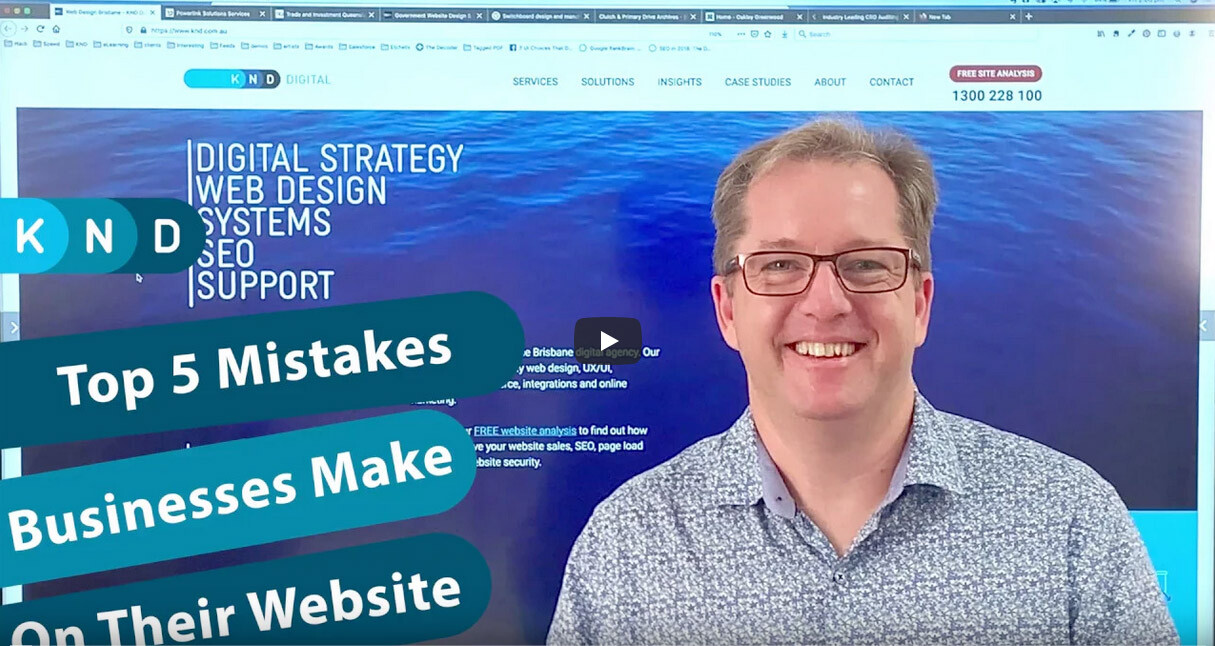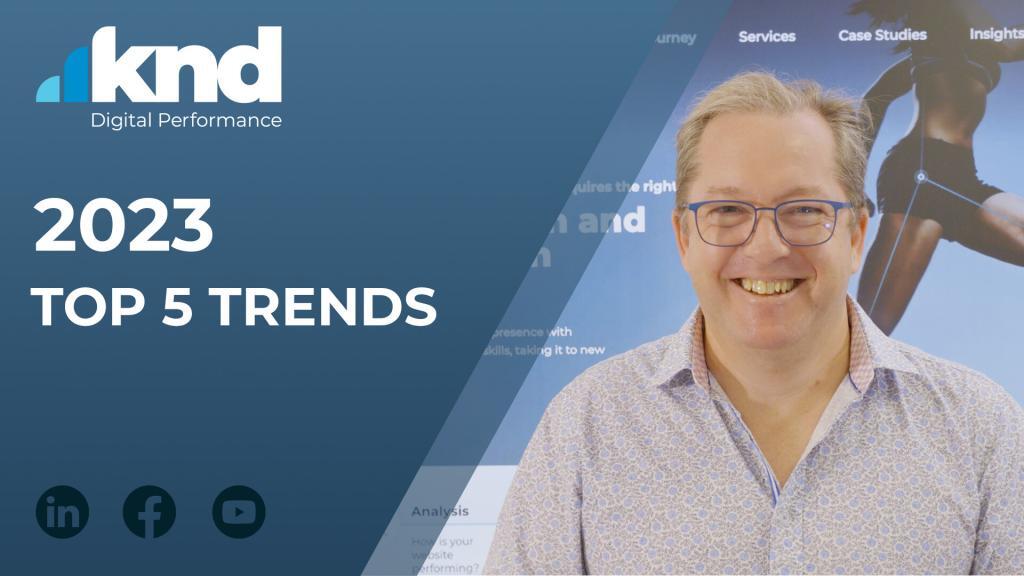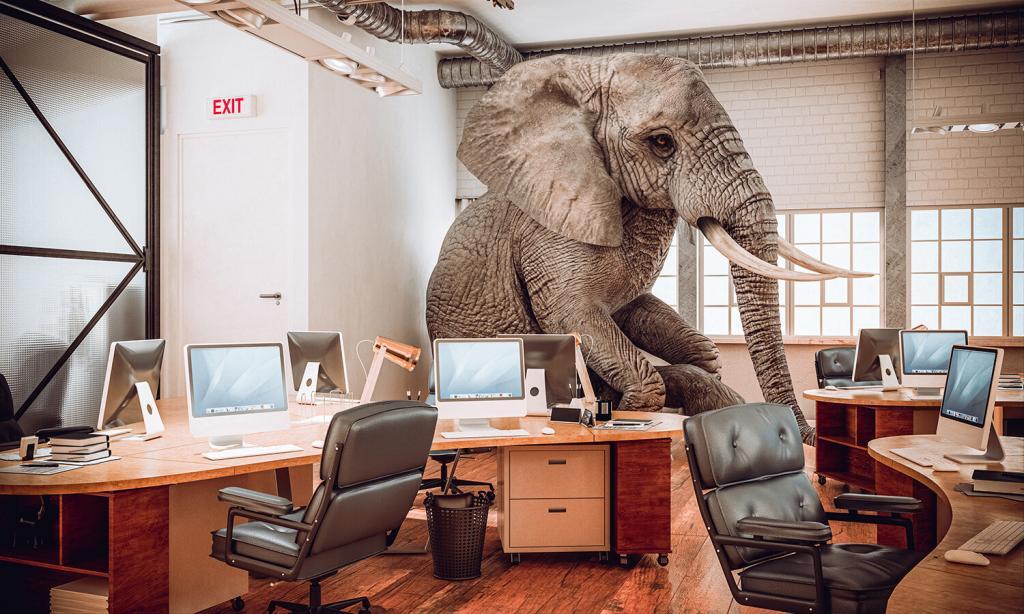
Hi everyone! I’m Jason Hawkins from KND Digital and today I’m going to take you through the top five mistakes business owners make when they’re building their website and particularly planning their website. Over the years we’ve built hundreds and hundreds of websites with work with business owners small through to large organizations. And these are the critical things that tend to get in the road of the project really trying to be a success, or the challenges that business owners face when they’re thinking about taking their business into the digital world. Really from a user’s perspective and how to engage our users online. How they think about their business at a really core level and how people see their business.
Before I do dive into the top five mistakes business owners make when building their website, If you find our information useful and you’d like to hear more from us, please don’t hesitate to subscribe with the button down below. We release a weekly information bite about digital and web and I would love to have a conversation with you if you have a question about your site and your strategy please don’t hesitate to reach out as well in the comments and we’ll engage there.
It’s great to see online and thank you for watching, so the first topic is really the first mistake that a lot of business owners make is being too inwardly focused! So they go yes we do X Y and Z in our business, these are the services we offer and we do X Y Z. And that’s really a problem for people who come in from the outside. So say a prospective customer travels to your site and you’re trying to find out whether there’s a good match for the service… obviously online now it’s extremely competitive so there’s thousands of different businesses all from the same sort of services, so how are you going to engage with that and usually it is delivering information back to the customer. Having a customer focus, a customer drive to the site so we call that user experience what is that user experience or customers experience, when they land on the site.
So here’s an example of a pretty bad or an example just of our inwardly focused site and it happens quite commonly in B2B even B2C – where business owners will just go hey these are the list of things we do. You contact us to find out more, so here’s an example of that, these guys are PowerLink Solutions here’s our services PowerlInk Solutions deliver electrical solutions they’ve got seven seven or eight different services they don’t explain when they go do anything into any detail. In fact one of the the industry sector that we see this the most problematic in is like engineering, building and construction sometimes in health. They assume that everyone knows or wants to do business with them. They have a very technical head engineers just want to get the job done… bup bup bup, thought but they haven’t really thought about how to really engage their prospect and go hey can we connect online in any way.
Now how do we do that?
So we structure pages that’s an outwardly looking focus so what does that look like? Say I sell tiles and I have tiles for a DIY homeowner I have tiles for tradies I have tiles for larger commercial builders so there’s an example of a “solutions for” style. We have a solutions for a tradie, we have a solution for commercial, we have solutions for residential. See I’m defining my markets each time – with that in mind, so I’m getting that user to go okay yeah I’m a residential guy or I’m a commercial guy I need that information. You’re designing a smooth pathway to land on that site, so if we have a look at Trade Queensland there’s a big large state Government run Department, so we work with these guys several years ago now and here’s a really good example… They have three user group… Invest. Those that want to invest in Queensland those that want to BUY stuff from Queensland and those people in Queensland that want to Export. So it’s a good example of showing you this sort of user connection rather than just go pay I anyone who is investing or buy from us here’s our structure here’s our rules here’s our da da da.
So yes they engage in each of those so each of the sites and large-sized wisely has it quite a significant menu mega menu that’s connected to those, but it’s it allows the user to define who they are and give them the journey, rather than just going hey I do switchboard designer manufacture.
Oh you know yes I might want a switchboard but hey what size of switchboard either the switchboard for a mega factory or a small home? You know it’s oh really it’s an interesting scenario and you can see where I’m going with with that. Do not fall for that “we just do this”… inwardly focused. You need to think about your customer and how they connect with you.
So the second mistake that businesses make, is not planning for search!
Being found is absolutely mission critical in any website these days and you’ve got to make it easier for yourself and it was particularly got to make it easier for Google to find you. And how do you do that? It’s about structuring your page navigation and landing pages to suit your product or service and which market you’re going to. More and more today this is heading towards much more niche focused. You don’t want to spread your words too broadly. You need to be thinking niche how am I going to connect with my audience through search.
As an example of that, say I do want to perform for switchboard design and manufacture. This page is it is a good example firstly each of these services should have their own page there should be a “switchboard design page” there should be a “programmable logic control page” there should be your “PLC and motor control center” page and then you can define the content and connect that content back to Google search. So as an example if I am in Google search I’ll go and I’ve searched for switchboard design and manufacture there’s an easy way when you’re planning to actually go hey what are people searching for?
And how can I define my pages?
So here you know there’s predictive search that Google just delivers up to you so you can start typing in it yes and find the appropriate… as its predictive… it’s displaying the search terms that it thinks are relative and that lots of people are searching for so you can make some pretty clear decisions about how you name your pages and put your headings in place in the pages and structure your pages for SEO in by just using that simple term. You can also scroll to the bottom after you’ve done a search and you’ll see these are recommended searches down here that may or may not be a really good connection for you for your particular service.
But it can spark ideas about how what pages you name and how you name them so that you set yourself up for success in search.
Absolutely mission-critical and a lot of business owners ignore that and they wonder why it hasn’t worked for them.
Now I just like to give you another example of that I came across a business a few days ago these guys sell motorcycle parts for Harley Davidsons Indian motorcycles etc and this is a good example of category structures. This is in a product based ecommerce website and their primary category name is “clutch and primary drive” now that is way way too broad, it needs to have a heading that’s at least “Motorcycle Clutch” and primary Drive this is the key now all these words down here has don’t even mention motorcycle, little on the page titles and the other elements and the page names just don’t really give it is it’s not really set up for success.
It needs to be set up so that your categories are working for you that your page content is working for you in search.
The third mistake that businesses make when playing their website is not connecting with the end user at a personal level.
So many times I see business owners that just just ignore the fact that they have a profile they want to hide they want the business but they don’t want to actually reach out and really connect with their users and put themselves out there online some businesses even go to the extent of hiding their phone numbers they just want a contact form with no address or service offering, thinking that they’re just want a you know connect via form online versus a phone call. Look just get over you need to be putting yourself out there it’s way too competitive these days to stress about that. You need to get out there. Not only you should be doing video of course, but you shouldn’t be hiding contact details.
Make it easy for our people to connect with you. Now that’s not just your contact in touch but it’s also describing your culture and a personality of your business. So what do I mean as an example of that? Oakley Greenwood are a B2B consulting firm high end gas electricity consulting firm, and they put their people pages pretty much first in the structure and why do they do that? Because that statistically people pages in B2B business websites are the second most visited page outside of the home page.
So you need to set that up for success!
Build nice profiles for people Connect that expertise in with the service offering that you can use, build project connects to projects with people people love dealing with people online and you can do that really easily by structuring that in your site and factor in that into your design. So for example in Oakley Greenwood there’s the people navigation I can dive in and see the profiles of all the people involved in the particular business.
So there we go diving in now lots of sites have this sort of style of information that’s not uncommon. However if I go to industries and I go to electricity… so I am in an expertise style page now. Here we go, we’ve got “meet our experts” in here and we’ve got our headshots and I can inquire there and connect with that person straight away. I know if I’m gonna pick up the phone and talk to these guys I know that Jim Snow who is an expert in this area so I can ring hey Jim I need to talk about XYZ.
This is really important we’re also connecting reports that are written by Jim Snow etc. We’re also describing clients that out they have relationships with so it painting a full picture of that relationship based consulting that is so important in business-to-business.
The fourth mistake business make online commonly when they’re planning is “failing to guide the user” so what does that mean? We want a user flow or right user journey through our digital experience that is smooth. So iron out the creases in and resistance points in the site to keep the user engaged. So guide the user to an outcome that we want to happen.
As an example of that and I’m going to stay with B2B at the moment, because in in e-commerce it’s pretty straight forward it’s it’s more of a straightforward linear relationship if you like where you navigate for a particular product you are the search for guide through the categories land on the part put the product in the cart checkout and all of those if you’ve if you’ve nailed that flow then usually you’ll get the sale which is which is great yes you can follow them with abandonment, strategies if they exit but essentially it’s a corner linear flow however, in a B2B situation you want to tell that story and encourage that engagement if you like.
Now I work closely with the Conversion Kings like these guys are killers at conversion optimization in Australia and the rest of the world they are just leading the example. And here’s an example of their CRO conversion rate optimisation auditing page and it tells a story of that engagement so we’ve got out what is it how does it work.
They break it into their particular services will they do conversion audits while they do UX audits very clear segmented simple information very readable they have a testimonial in place so, we’re reinforcing that trust and that relationship with the user as they’re scrolling in the page and these longer scrolling pages give a nice feel of flow through the site as well. In the in the old days we used to have to dump people onto different pages and get them to click and click and click and click but now we can tell a nice smooth experience or a story down the page so we’ve got our testimonial what else do you want to see you want to see who else this businesses work for in this flow so we’re you know there’s all this leadbox Australian National Maritime Museum some big players, they have already planted subconsciously in the users mind the type of businesses these guys work with.
It really connects to that end user so and then, we’re actually asking with a local real person with Ben who’s in the business he’s asking you if you’ve got any questions so there’s an engagement piece right there a nice solid call to action in that flow that really connects the end user, you don’t want to waste the visitor actually looking at this without trying to ask them to do something next that’s the whole idea.
Failure to guide the user you don’t want to fail that otherwise you’ll lose people! They’ll just go to another site you want to engage them capture them and get them to inquire.
The fifth issue we have isn’t quite like the user experience issues I have before the tip with our top five. Our fifth is waiting for perfection a lot of business owners especially small business owners who have maybe some little control freak issues in their lives, want everything to be absolutely spot-on with everything I’m not talking just about relationships of pixel widths and spacing but it could be a particular word it could be something in this site that they’re just not quite happy with.
Well you need to get over it business owners just leave that alone!
Get the site out there life get stuck into actually releasing your site and and make a commitment to getting it live. Because you can always go in and change it web sites are malleable fluid elements that you can mold over time you can’t just sit and forget it needs to be an active in motion part of your marketing strategy and that’s why it’s so important to just let that crap go and move on and get some your site live.
It can be so hard to commit sometimes with people I get really nervous about all these things don’t fall for that trap don’t fall for that fifth mistake just get your site live and then make some tweaks as after you go it’s just going to be a moving target the whole way where every month every year just make it happen and get into it.
So if you really liked this our top five then I really love you to subscribe or leave a comment ask a question and we’ll engage you can go to the comments and I look forward to seeing you next week.




